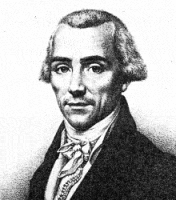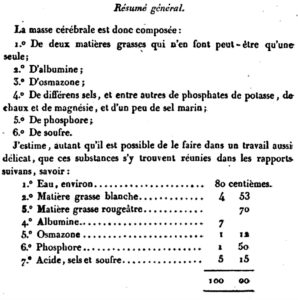

He was born at St André d’Hébertot, in Normandy, his father Nicolas Vauquelin being an estate manager. At fourteen, he became assistant to a pharmacist in Rouen where he attended to lectures on chemistry and pharmacy. After a short time, he went to Paris and worked for a pharmacist named Chéradame, a cousin of the famous chemist Fourcroy. There he spent two years learning Greek, Latin and the sciences. About 1785 Vauquelin became an assistant in the laboratory of Fourcroy where he developed rapidly close relationships with his master, resulting in over fifty joint publications.
He left Fourcroy’s laboratory by 1792 and became the manager of a pharmacy and thereafter a hospital pharmacist at Meaux. In September 1793 he organized in Tours the production of saltpeter needed for gunpowder. In 1794 he resumed his association with Fourcroy when he was appointed assistant professor of chemistry at the new Ecole Centrale des Travaux Publics. In 1795 he was master in pharmacy, became Inspecteur des Mines and was elected to the Institut de France. The next year he was professor of chemistry at the Ecole de Pharmacie, and at the Collège de France in 1801. In 1803 he became director of the Ecole de Pharmacie on its foundation. In 1804, succeeding Brongniart, he became Professeur de Chimie appliquée aux Arts, at the Jardin des Plantes, with lodging and laboratories at the Muséum d’Histoire Naturelle.
He was there once again a colleague of Fourcroy, whose death in 1809 left a vacant chair in chemistry at the Faculté de Médecine. He succeeded Fourcroy in 1811 but after gaining his doctorate of medicine by a famous thesis on the composition of the brain (Analyse de la matière cérébrale de l’homme et de quelques animaux, Paris, Med Fac, 1811, published in Ann Muséum Hist Nat 1811, 18, 212) (English translation in : Ann Phil London, 1813, 1, 332-346) While the presence of phosphorus in brain tissue was first reported in 1719 by Hensing JT (Professor of medicine et the University of Giessen), its presence in lipids extracted from brain with ethanol was reported for the first time by Vauquelin in his thesis.
He states in this thesis that the isolated substance was “white, solid but soft, and sticky; that it had a satiny and bright aspect, that it stained paper in the way that oil does”. He stated that “a portion of this material, which had been dissolved several times in alcohol in order to separate out from it the last of the animal substance (or protein), was burned in a platinum crucible. … The carbonized residue, washed with distilled water, rendered this fluid very acidic, with its ability to precipitate lime water. The unusual result of this procedure which, evidently indicated the presence of phosphoric acid, made me suspect that this fatty substance contained phosphoric acid in combination”. ” I believe that I can conclude from these experiments that the brain substance involved here contains neither free phosphoric acid nor ammonium phosphate, and that consequently the acid which forms in the course of combustion has another origin…….What is to be concluded from these experiments if not that there is phosphorus combined with fatty material in the brain and that the former is dissolved along with that fatty substance in alcohol? … One must necessarily accept that phosphorus is present in the substance of the brain, just as in the roe of fish, as discovered by Fourcroy and myself”. “Although the substance we have described offers a closer relationship to the fats than to all other classes of substances, nevertheless it should not be identified with ordinary fat. It differs from fat mainly by its insolubility in alcohol, by its ability to form crystals, its viscosity, its lesser fusibility, and the black color, which it assumes on melting. Thus, while classifying it among the fatty bodies, it must be regarded as a specific and new substance”.

Conclusions of the Vauquelin’s thesis
These results were destined to play an important role in the history of neuroscience, as they were obtained after the first complete analysis of the brain. The thesis was not only published in France, but soon appeared in translation in German and English journals. Moreover, his extraction of ‘white matter’ from brain tissue with boiling alcohol, and its precipitation after cooling, became the first step for several later investigators of brain chemistry.
Vauquelin was dismissed in 1822 for holding too liberal political views but pensioned in 1823. One year before his death he was elected to parliament as a deputy for Calvados.
Vauquelin never married and lived from about 1790 with two sisters of Fourcroy until they died.
The impact of his thesis on the brain analysis was rapid and widespread. The text was reprinted in several scientific journals in France, England and Germany. This work can be considered as one major stimulus for all subsequent studies on brain lipids. Thudichum wrote in 1874 that “Vauquelin’s data are perfectly correct as far as they go; they furnished an excellent basis upon which the moreperfects methods of later times might have built a complete analysis of brain matter”.
The most important chemical analysis of Vauquelin were made on vegetable and animal substances. Thus, he discovered allantoin and asparagine (the first ammino acid to be recognized), confirmed the existence of malic, quinic and several other organic acids. He studied the comparative aspects of urea, uric and hippuric acids. In the course of mineral analyses, he discovered in 1798 chromium and beryllium.
Progressively, Vauquelin became one of the leading analytical chemists of Europe. Vauquelin’s friends were not only Fourcroy but also Lavoisier, Berthollet, Haüy, Gay-Lussac, Pelletier. Among his pupils we can noticed Chevreul, Orfila, Robiquet and Thénard, without missing several foreign scientists linked to the French chemist group.
DISPERSIVE LIQUID-LIQUID MICROEXTRACTION
Lire la suiteDevenez membre et participez au développement de la Lipidomique au XXIème siècle.
S'inscrire